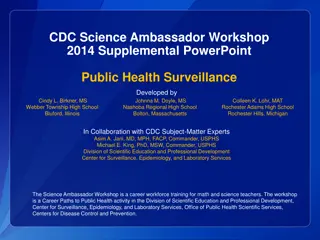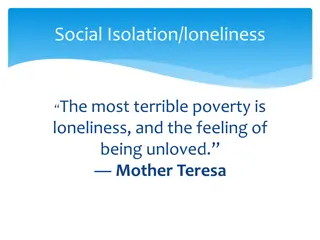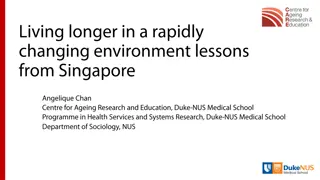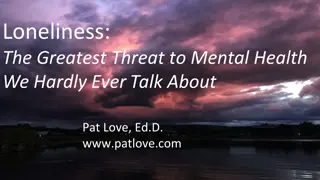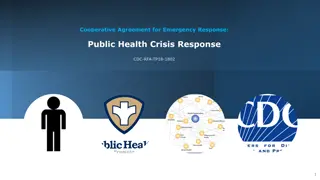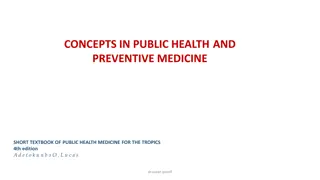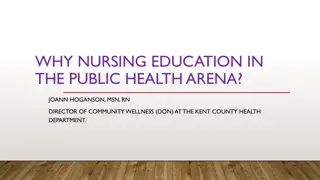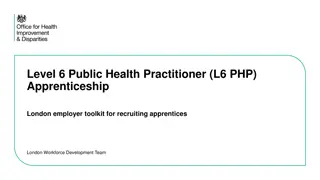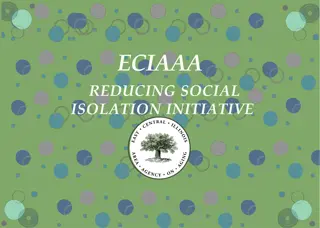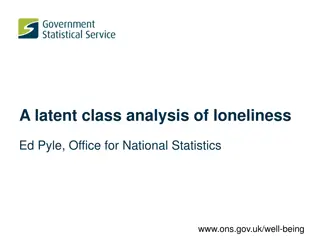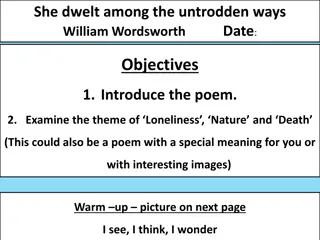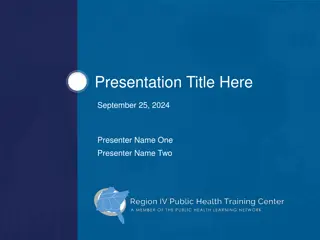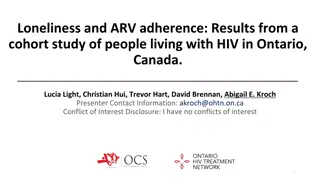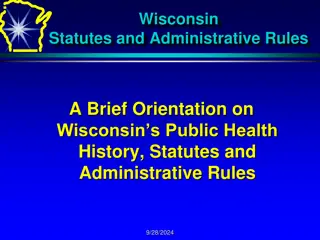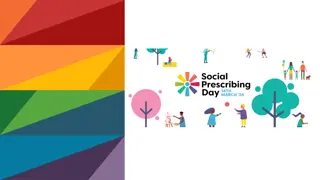Lonely Together: Exploring the Impact of Loneliness on Public Health
Professor Roger O'Sullivan discusses the significant public health issue of loneliness, emphasizing the importance of understanding its various types and associations with health and well-being over the years. The presentation delves into definitions, social characteristics, and terminology related to loneliness, highlighting its subjective and objective aspects. It explores different types of loneliness, its transient nature, and the profound impact it can have on physical and mental health. The discussion also touches upon data surrounding loneliness before and during the COVID-19 pandemic.
Download Presentation

Please find below an Image/Link to download the presentation.
The content on the website is provided AS IS for your information and personal use only. It may not be sold, licensed, or shared on other websites without obtaining consent from the author. Download presentation by click this link. If you encounter any issues during the download, it is possible that the publisher has removed the file from their server.
E N D
Presentation Transcript
Loneliness - a public health issue Prof Roger O Sullivan Institute of Public Health
Overview 1. Understanding loneliness - why definitions matter! 2. Social and demographic characteristics associated with loneliness in Northern Ireland 2
Loneliness - a very personal experience Loneliness - a negative emotional feeling, the outcome of the difference between one s desired and achieved social relations (Burholt 2018, Perlman & Peplau 1981) 4
Terminology matters - Loneliness & Social Isolation Loneliness Subjective More hidden Social Isolation Objective Easy to measure e.g. size and number in your social network (Prohaska, et al 2022)
3 main types of loneliness: 1. Social loneliness 2. Emotional loneliness 3. Existential loneliness (Mansfield et al 2019)
Loneliness can be: Transient - e.g. bereavement, retirement, becoming a carer Situational - e.g. COVID pandemic Occasional - a feeling that comes and goes Chronic - here one feels lonely all or most of the time (Prohaska, et al 2022)
Loneliness and health Associations with poor health and wellbeing have been established for over 30 years. Evidence suggests associations with depression and anxiety, non-communicable diseases (e.g. cardiovascular disease), health behaviours (e.g. smoking), stress, sleep, cognition, frailty and premature mortality (with the evidence especially strong for depression) (Cacioppo 2010, O Sullivan et al 2021, Prohaska, et al 2022) 9 9
Loneliness data before and during COVID-19 Pandemic 10
Loneliness in people (16+) with and without a limiting, longstanding illness, NI 2020-21 Often/ always Some of the time/ occasionally Hardly ever/ Never 12% 39% 48% With limiting longstanding illness 3% 30% 67% No limiting longstanding illness Source: NISRA 2021
Loneliness by deprivation quintile, NI 2020/21 37% 33% 32% 30% 30% 8% 6% 5% 5% 4% Most deprived areas Q2 Q3 Q4 Least deprived areas Often/always Sometimes/ occasionally Source: NISRA 2021
Loneliness in NI by gender 2018/19 & 2020/21 (16+) 36% 33% 28% 26% 6% 6% 5% 4% 2018 2020 2018 2020 Male Female Often/always Some of time/ occasionally 13 Source: NISRA 2021
Loneliness in NI by urban/rural areas, 2018 & 2020 - 16+. 34% 32% 29% 27% 6% 6% 4% 4% 2018 2020 2018 2020 Urban Rural Often/always lonely Some of the time/ occasionally Source: NISRA 2021 14
Frequency of loneliness by household type in NI Number of persons in household 1 Year Often/always Some of time/ occasionally Hardly ever/ never 2018/19 2020/21 2018/19 2020/21 2018/19 2020/21 2018/19 2020/21 2018/19 2020/21 14% 44% 43% 16% 45% 39% 2 4% 27% 69% 4% 29% 67% 3 5% 30% 65% 4% 35% 61% 4 2% 29% 70% 3% 27% 70% 5+ 3% 20% 77% 1% 29% 70% Source: NISRA Source: NISRA 2021
Loneliness in NI by age, 2018 and 2020/21. NISRA Often/always Some of time/occasionally 42% 33% 34% 37% 30% 30% 28% 29% 33% 30% 32% 29% 27% 25% 8% 7% 7% 7% 6% 6% 5% 5% 5% 4% 4% 4% 4% 4% 2018 2020 2018 2020 2018 2020 2018 2020 2018 2020 2018 2020 2018 2020 16-24 25-34 35-44 45-54 55-64 65-74 75+ Source: NISRA 2021
Summary/Conclusion: Loneliness and associations with poor health and wellbeing have been established for over 30 years Not all groups are at equal risk of experiencing loneliness Loneliness is very personal and it is important to understand the type, frequency and cause 17
References Burholt V, The complexity of loneliness in later life: addressing the issues. loneliness in later life: interventions what works?, Belfast, Northern Ireland. Cacioppo JT, Hawkley LC, Thisted RA. Perceived social isolation makes me sad: 5-year cross-lagged analyses of loneliness and depressive symptomatology in the Chicago Health, Aging, and Social Relations Study. Psychol Aging. 2010; 25: 453 Mansfield L, Daykin N, Meads C, Tomlinson A, Gray K, Lane J and Victor C (2019) A conceptual review of loneliness across the adult life course (16+ years): Synthesis of qualitative studies. London: What Works Centre for Wellbeing NISRA (2021) Coronavirus (COVID-19) Opinion Survey Key Findings from Phases 1 to 8. Published 18th Feb 2021. Additional tables supplied by NISRA. O'Sullivan R, Lawlor B, Burns A, Leavey G. Will the pandemic reframe loneliness and social isolation? The Lancet Healthy Longevity, Vol 2, 2021 Perlman D, Peplau LA. . Toward a social psychology of loneliness. in S.W. Duck & R. Gilmour (eds) Personal Relationships 3: Personal Relationships in Disorder. London: Academic Press 1981;3:31 56. Prohaska T, O'Sullivan R, Leavey G, Burns A. A public health approach to loneliness and isolation among older adults. In: Scrimshaw SC, Lane SD, Rubinstein RA, Fisher J, eds. The SAGE handbook of social studies in health and medicine, 2nd edn. London: Sage, 2022.
Email : roger.osullivan@publichealth.ie Web: www.publichealth.ie www.twitter.com/publichealthie








